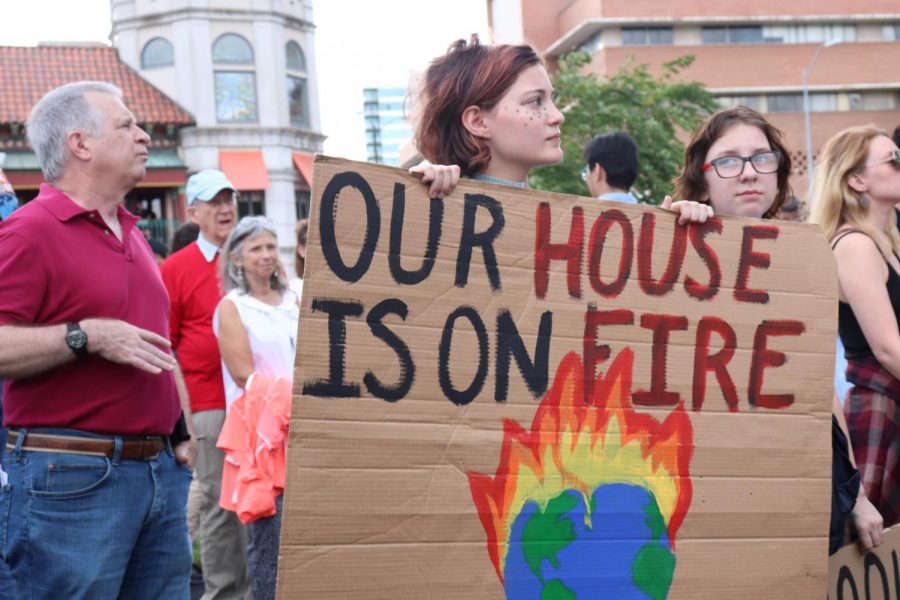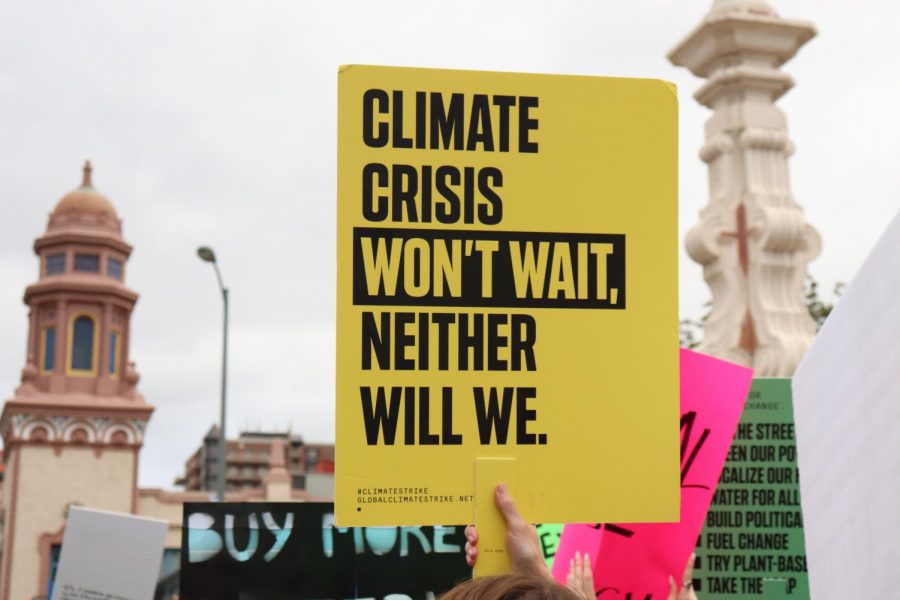Playing with Fire
As the Amazon burns, the climate crisis is front and center for the world.
PHOTO | Kamryn Rogers
A look at the climate crisis and how sustainable living can reduce our ecological footprint.
(September Le Journal Issue 1 Cover Story: http://bit.ly/2nSSb4Q)
As flames engulfed the trees and brush of the Amazon, the world wept. A precious ecosystem home to thousands of species burns, and destruction is inevitable. Although some news sources and political figures believe the fire is due to dry weather and hot winds, it is ultimately the start of something bigger. It is believed that the fires are human-lit or induced with the intention to clear land for cattle ranching and agriculture. The process of “slash and burn” has been used more and more recently in order to increase cultivation and development. In cities with higher amounts of development, the release of greenhouse gases such as methane and carbon dioxide alters the atmospheric temperature of Earth and disrupt the greenhouse effect. Due to the Earth’s atmosphere, heat from the sun gets trapped and makes the planet warm enough to sustain life, similar to the purpose of a greenhouse, according to The National Aeronautics and Space Administration.
“This destruction is very harmful not only to Brazil and other countries where the Amazon is located, but to everyone, as it directly influences the world climate through its giant trees which contribute decisively to the regeneration of the atmosphere,” sister Brazilian school Notre Dame de Sion junior Carllos Donatoni said. “The Amazon has the largest biodiversity in the world and many endangered animals live within it, so it’s important to ensure greater natural sustainability for all life forms.”
As disastrous as the fires are, other environmental issues are just as important. The topic of sustainability has earned increased media coverage recently due to the desperate need for change, and by sustainably living and working together, the global ecosystem can be saved.

During the climate strike at the Plaza Sept. 20 there were multiple speakers ranging from high school students to elected officials. The crowd had many generations represented.
UP IN FLAMES
Destruction. Fire. Floods. The climate is changing and humanity is walking a thin line around the tipping point. The global climate crisis affects every aspect of the planet, and without a change in lifestyle, the results will be catastrophic. Greenhouse gas emissions have reached dangerous levels and are increasing atmospheric temperature. The amount of carbon dioxide within the Earth’s atmosphere hadn’t reached above 300 parts per million for millennia, up until the Second Industrial Revolution in the 1950s, according to The National Aeronautics and Space Administration.
“Many people don’t realize that methane gas is close to 25 percent more potent than carbon dioxide,” AP Environmental Science teacher Amy Vandenbrul said. “We talk a lot about fossil fuel emissions, but methane is actually a much more potent greenhouse gas.”
Although carbon dioxide occurs naturally, human usage causes similar gases to act as a blanket, according to the World Wildlife Fund. As that blanket gets heavier and heavier, the planet’s surface gets warmer and warmer. Glaciers and ice caps can’t survive the impending heat and progressively retract and erode, causing large chunks of ice to break off into the sea. Not only is this threatening for wildlife habitats on top of the ice, but also the ones down below. Temperature fluctuation, even by the slightest degree, drastically alters the flow and balance of ocean life. The majority of the trapped heat is absorbed into the ocean water, and the surface layer is heating 24 percent faster than it did a few decades ago, according to National Geographic.
Twice the size of Texas, floating halfway between Japan and California, The Great Pacific Garbage Patch sucks the life out of the ocean ecosystem. A “dead zone,” light struggles to get through plastic layers, resulting in life being incapable down below the surface of the water. Plastic takes hundreds of years to decompose, making it one of the worst types of wastes and most dangerous to the ecosystem, according to The Daily Telegraph.
“We want to help people learn about how to replace single-use plastic in their lives, and especially in the lunchroom,” sophomore Green Team Co-President Kat Riggs said. “We use a bunch of coffee cups and plastic silverware, and it’s all going to waste.”
HOW THIS AFFECTS YOU
Climate change and other environmental issues affect Americans not just globally but locally, regionally and eventually individually in regions like personal, physical health, food security and clean water and air supply. They are ‘expected to become increasingly disruptive throughout this century and beyond,’ according to Global Change.
As a result of climate change, extreme weather like hurricanes, tropical storms, forest fires, flooding and other kinds of natural disasters are expected to drastically increase. Researchers from Princeton University project a 45 to 87 percent increase in the frequency of Category 4 and 5 hurricanes in the continental United States and Atlantic Basin. Wind speeds are expected to increase by 2 to 11 percent due to the warming sea surface temperatures, according to a study done by the American Meteorological Society. Warmer sea temperatures have already begun to increase precipitation rates by about 20 percent.
The increasing temperature will also increase the transfer of diseases, especially vector-borne diseases, which are transferred by mosquitoes, ticks and flees, because the warmer seasons in which they survive will be elongated, according to the United States Environmental Protective Agency. Bacteria that spread diseases are also able to manifest and grow faster in warmer climates.
The increase of carbon dioxide in the air is expected to disrupt the distribution of food and increase the risk of exposure to harmful chemical components, according to the Environmental Protective Agency. Rising sea levels will lead to more mercury in seafood, and flooding is expected to ruin millions of crops.
“The influx of carbon dioxide into our atmosphere is obviously a huge, glaring problem, but it’s important not to solely focus on that,” Vandenbrul said. “There’s so many other issues like the methane that comes with fracking.”
Eighty percent of greenhouse gas pollution lies in urban, poor areas, according to the same report, so the poor will be affected the most by that. With the heating of the atmosphere, the lower class will not be able to move when environmental conditions worsen, and they won’t be able to protect themselves against the increasing heat with air conditioning or other cooling methods. Sustainability is often costly,
“Individual actions are great like carpooling or switching to electric vehicles, but the fact of the matter is, a lot of those ways to be sustainable aren’t accessible from a financial standpoint for a lot of people,” Sims said.
WHAT IS BEING DONE?
Continuous political and social debates have circled around how to solve the climate crisis for years. Without solid laws and regulations in place, usage and waste control has no limit. Environmental groups in and around the Kansas City area have made it their mission to serve the planet through political marches, boycotts and awareness.
Heartland Conservation Alliance, a group of environmentalists in the Kansas City region, work to conserve natural lands and resources, while educating others on the importance of protecting the environment. Their youth council supports teenagers that are passionate about the environment and want to make a change.
“We’re putting on an Anti-Litter campaign,” senior and HCA member Ceresa Munjak-Khoury said. “We’ve printed out a bunch of stickers to pass out that provide information about litter, especially about our KC community and what you can do to help.”
Pollution in major cities is one of the biggest issues facing sustainable living, and it can range anywhere from air, to plastic, to water. Fighting for free or reduced bus fair, carpooling to and from work and finding alternatives for imports into the city could reduce the levels of fossil fuel emissions greatly, according to University of Missouri Kansas City Student Environmental Coalition President, Dawson Sims.
“Kansas City is a town that is based a lot around transportation, so many of the sources of emissions we use in this area comes from that transit,” Sims said. “There is pollution from diesel-powered engines that are causing breathing problems in residential areas, especially close to major highways.”
To improve efforts around the school, Green Team has built a composting pile in the lunchroom so students can get rid of waste sustainably. With simple directions on the box, students and faculty can help keep the school green while also learning about the benefits of composting.
“We want to educate our community on how to use the trash, recycling, and compost bin efficiently,” Riggs said. “We plan on making new signs around the school and educating girls on the advantages of sustainable living.”
HOW YOU CAN HELP
In the seemingly doomed face of the environment, many people believe that drastic, global lifestyle changes may be the only way to cease or slow down the environmental crisis. However, there are ways that individuals can help without too much commitment to a life of sustainability and while staying local.
“There’s so many ways to get involved locally that may seem a little modest and small, but it’s really impactful,” HCA Outreach Coordinator Sarah Dunn Pickrell said. “The environment is completely interconnected, and local work helps more than a lot of people realize.”
HCA’s volunteer opportunities mostly focus on cleaning upkeeping the Blue River. They also have a student-led council, which gives student Munjak-Koury a leadership role in the environment. The student-led council focuses on raising awareness to certain environmental issues, such as littering, and host events centered around environmental education.
“It’s a really cool thing to be a part of, especially since I’m surrounded by other teenagers,” Munjak-Koury said. “We’re all banding together to make change.”
Another simple, cost-effective way to help is through political action. The Sunrise Movement, an organization that combats climate change with hundreds of protests a year, offers a multitude of dates to participate in organized protests nation-wide, all focused on issues specific to local issues. An even easier way to get involved is to call or write local representatives, asking them to support green programs, like the Green New Deal. Sims believes that activism in local communities is a key factor in combating climate change.
“These are individual actions you can take that have system-wide ratifications,” Sims said. “Activism at a local, state and national level is the most important thing a person can do.”
Easy changes can make a big difference. Swap a plastic water bottle for a reusable one, a plastic straw for a biodegradable, bamboo straw and bring a reusable bag to the grocery store to reduce single-use plastic consumption Instead of buying the latest trendy clothes at fast fashion stores like Forever 21, go thrift shopping and use hand-me-downs to reduce chemical pollution in drinking water. To avoid air pollution and excess burning of fossil fuels, turn off the lights when possible and take shorter showers. Reduce meat consumption to fight animal abuse and stop greenhouse pollutants. To combat deforestation in the simplest way, add Ecosia, a Google Chrome extension, to browse on instead. Its developers plant a tree after a certain number of individual searches. To prevent unnecessary waste in landfills, take a few extra minutes to recycle.
“Everything a consumer chooses to do impacts the environment and also influences the culture of those around them,” Vandenbrul said. “There are small lifestyle adjustments like just simply turning off the water when brushing your teeth that certainly are possible, but we must really focus on being models for the next generations on how to be sustainable.



